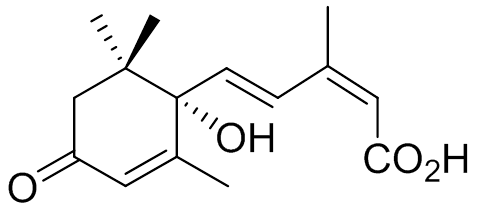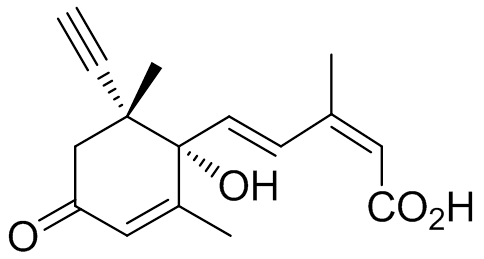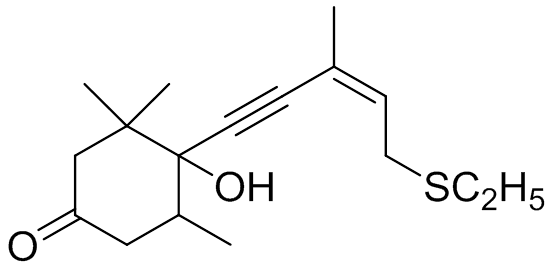ABA background

Abscisic acid
Abscisic acid (ABA), a monocyclic sesquiterpenoid carboxylic acid, is a signaling molecule found in all higher plants on the planet. ABA is one of the principal hormones that regulates plant responses to environmental stress as well as growth and development over the plant’s entire life cycle.
Some examples of plant processes in which ABA is involved are:
Abiotic StressABA acts at micromolar or lower concentration and the levels of the hormone are tightly regulated by a combination of enzymes involved in biosynthesis, catabolism and transport. ABA and the other principal hormone classes (ethylene, auxin, cytokinin, gibberellic acid, brassinosteroids, strigolactones and jasmonates) act through complex signaling networks. The mechanism of ABA action and plant hormone signalling is under intense study by researchers seeking to improve crop productivity (e.g. Cutler et al 2010; Annual Review of Plant Biology 61: 651-79).
ABA analog research program
Our current research on ABA chemistry at the University of Saskatchewan is focused on developing plant growth regulators as pre breeding tools for plant researchers and as plant growth regulators for horticulture and agriculture applications.
We are focusing on two different classes of ABA analogs:
1. Analogs with long lasting ABA effects
ABA itself is rapidly turned over in plants and is photolabile and is practical only for short term applications. Analogs resistant to plant catabolic enzymes while maintaining high bioactivity have applications in increasing plant stress tolerance.

8'-acetylene ABA
This analog was designed to inactivate a specific p450 monooxygenase that catalyzes the oxidation of the hormone in plants. In extensive testing, the molecule has turned out to have greater activity that the natural hormone and is very effective in substituting for ABA for prolonged periods of time. An example of the effects of the analog in a drought demonstration is shown below. Analog-treated plants were able to withstand water being withheld for 13 days, whereas control plants or those supplied with the natural hormone did not. This analog has practical application for reducing water use in turf grass, in bedding plant sales and distribution, “vacation proofing“ plants for home use, etc. (see video below)
2. Analogs that prevent ABA synthesis in plants
ABA is biosynthesized in plants by cleavage of a forty carbon carotenoid, to a fifteen carbon precursor xanthoxin, mediated by an enzyme NCED. We have developed analogs that bind in the active site of the enzyme and reduce ABA synthesis. These analogs have application in increasing seed germination under stress conditions and alleviating physiological dormancy.

ABA biosynthesis inhibitor
A project underway with Prof. Bunjamin Tar’an and colleagues in the Crop Development Centre USask focuses on developing ABA analogs for research in pulse agronomy and physiology. We are working to develop analogs that can be employed by plant breeders as prebreeding tools to overcome dormancy in seeds towards developing disease resistant crops and to shorten the time to develop new varieties. We are also investigating the application of ABA analogs as seed treatments to improve germination at low temperatures.

